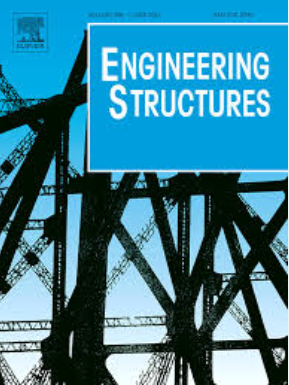Experimental, numerical and analytical investigation of fire resistance of prefabricated angle steel lattice concrete composite column
IF 6.4
1区 工程技术
Q1 ENGINEERING, CIVIL
引用次数: 0
Abstract
The angle steel lattice concrete (ASLC) composite column incorporates core concrete, concrete cover and lattice-type skeleton connected by angle steels and batten plates. The lattice-type skeleton is equivalent to the longitudinal and hoop reinforcement in ordinary concrete columns, simplifying connection and facilitating construction. Considering different thicknesses of concrete cover, fire tests without loading were conducted on four ASLC composite columns. Additionally, fire tests with loading were also performed on two full-scale ASLC composite columns. The experimental results also provided validation for the finite element model (FEM), and parametric analysis was carried out using ABAQUS, to reveal the impact of load ratio, thickness of concrete cover and eccentricity ratio on the fire behavior of the ASLC composite column. The results indicate that increasing the thickness of concrete cover leads to a linear decrease in steel temperature, significantly enhancing the fire resistance limit of ASLC composite columns. Accounting for the heat absorption properties of the concrete cover and core concrete, a temperature calculation method for angle steel based on the equivalent heat capacity method were proposed, as well as axial and eccentricity compression bearing capacity calculation method based on the reduced section method, which have high applicability for ASLC composite columns.
预制角钢格构混凝土组合柱耐火性能试验、数值及分析研究
角钢格构混凝土(ASLC)组合柱由核心混凝土、混凝土盖板和由角钢和板条板连接的格构骨架组成。格栅骨架相当于普通混凝土柱的纵箍筋,简化了连接,便于施工。考虑不同混凝土覆盖层厚度,对4根ASLC组合柱进行了无载防火试验。此外,还在两个全尺寸ASLC复合柱上进行了加载火试验。试验结果为有限元模型(FEM)提供了验证,并利用ABAQUS进行了参数化分析,揭示了荷载比、混凝土覆盖层厚度和偏心比对ASLC复合柱燃烧性能的影响。结果表明:随着混凝土护层厚度的增加,钢温呈线性下降趋势,显著提高了ASLC组合柱的耐火极限;考虑到混凝土覆盖层和核心混凝土的吸热特性,提出了基于等效热容量法的角钢温度计算方法,以及基于缩减截面法的轴向和偏心受压承载力计算方法,对ASLC组合柱具有较高的适用性。
本文章由计算机程序翻译,如有差异,请以英文原文为准。
求助全文
约1分钟内获得全文
求助全文
来源期刊

Engineering Structures
工程技术-工程:土木
CiteScore
10.20
自引率
14.50%
发文量
1385
审稿时长
67 days
期刊介绍:
Engineering Structures provides a forum for a broad blend of scientific and technical papers to reflect the evolving needs of the structural engineering and structural mechanics communities. Particularly welcome are contributions dealing with applications of structural engineering and mechanics principles in all areas of technology. The journal aspires to a broad and integrated coverage of the effects of dynamic loadings and of the modelling techniques whereby the structural response to these loadings may be computed.
The scope of Engineering Structures encompasses, but is not restricted to, the following areas: infrastructure engineering; earthquake engineering; structure-fluid-soil interaction; wind engineering; fire engineering; blast engineering; structural reliability/stability; life assessment/integrity; structural health monitoring; multi-hazard engineering; structural dynamics; optimization; expert systems; experimental modelling; performance-based design; multiscale analysis; value engineering.
Topics of interest include: tall buildings; innovative structures; environmentally responsive structures; bridges; stadiums; commercial and public buildings; transmission towers; television and telecommunication masts; foldable structures; cooling towers; plates and shells; suspension structures; protective structures; smart structures; nuclear reactors; dams; pressure vessels; pipelines; tunnels.
Engineering Structures also publishes review articles, short communications and discussions, book reviews, and a diary on international events related to any aspect of structural engineering.
 求助内容:
求助内容: 应助结果提醒方式:
应助结果提醒方式:


